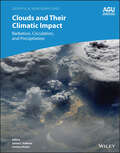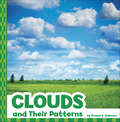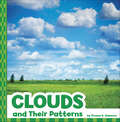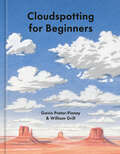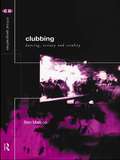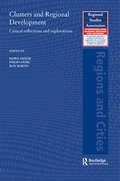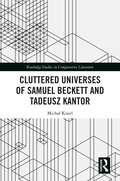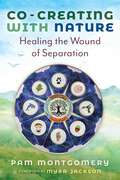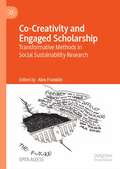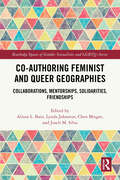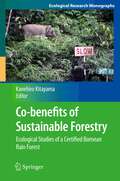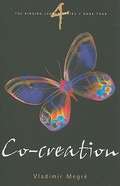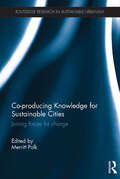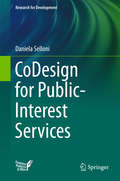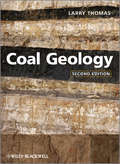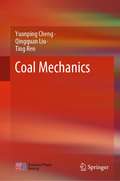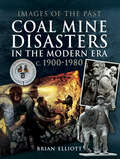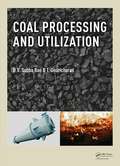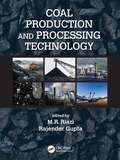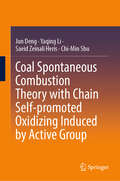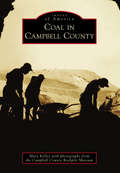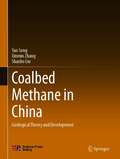- Table View
- List View
Clouds and Climate: Climate Science's Greatest Challenge (Space Sciences Series Of Issi Ser. #65)
by Sandrine Bony Bjorn Stevens A. Pier Siebesma Christian JakobCloud research is a rapidly developing branch of climate science that's vital to climate modelling. With new observational and simulation technologies our knowledge of clouds and their role in the warming climate is accelerating. This book provides a comprehensive overview of research on clouds and their role in our present and future climate, covering theoretical, observational, and modelling perspectives. Part I discusses clouds from three different perspectives: as particles, light and fluid. Part II describes our capability to model clouds, ranging from theoretical conceptual models to applied parameterised representations. Part III describes the interaction of clouds with the large-scale circulation in the tropics, mid-latitudes, and polar regions. Part IV describes how clouds are perturbed by aerosols, the land-surface, and global warming. Each chapter contains end-of-chapter exercises and further reading sections, making this an ideal resource for advanced students and researchers in climatology, atmospheric science, meteorology, and climate change.
Clouds and Their Climatic Impact: Radiation, Circulation, and Precipitation (Geophysical Monograph Series #281)
by Corinna Hoose Sylvia C. SullivanClouds and Their Climatic Impacts Clouds are an influential and complex element of Earth’s climate system. They evolve rapidly in time and exist over small spatial scales, but also affect global radiative balance and large-scale circulations. With more powerful models and extensive observations now at our disposal, the climate impact of clouds is receiving ever more research attention. Clouds and Their Climatic Impacts: Radiation, Circulation, and Precipitation presents an overview of our current understanding on various types of clouds and cloud systems and their multifaceted role in the radiative budget, circulation patterns, and rainfall. Volume highlights include: Interactions of aerosol with both liquid and ice clouds Surface and atmospheric cloud radiative feedbacks and effects Arctic, extratropical, and tropical clouds Cloud-circulation coupling at global, meso, and micro scales Precipitation efficiency, phase, and measurements The role of machine learning in understanding clouds and climate The American Geophysical Union promotes discovery in Earth and space science for the benefit of humanity. Its publications disseminate scientific knowledge and provide resources for researchers, students, and professionals.
Clouds and Their Patterns (Patterns in the Sky)
by Thomas K. AdamsonWhat are clouds? How are they made? And why do they seem to move cross the sky? Learn the answers to these questions and more in this easy-to-read title and discover the science behind clouds and their patterns.
Clouds and Their Patterns (Patterns in the Sky)
by Thomas K. AdamsonWhat are clouds? How are they made? And why do they seem to move cross the sky? Learn the answers to these questions and more in this easy-to-read title and discover the science behind clouds and their patterns.
Cloudspotting for Beginners
by Gavin Pretor-Pinney William GrillA beautifully illustrated guide to clouds and the sky for inspiring and educating curious minds with meteorological wonder.Renowned journalist, public speaker, and founder of the Cloud Appreciation Society Gavin Pretor-Pinney details the key facts and characteristics about each major cloud type. To accompany these scientific tidbits, William Grill&’s gorgeous illustrations of vast colorful skies and mesmerizing cloud patterns create a calming, thought-provoking learning experience.From low-lying Stratus to high-flying Cirrus, Cloudspotting for Beginners covers how clouds are formed, the altitudes they prefer, the curious shapes they take, how they affect other meterological events, and more. The book breaks down the life and structure of a cloud on a molecular level, and then even expands on their interesting cross-planetary variations—for example, Jupiter&’s clouds are composed of ammonia ice crystals and Saturn&’s clouds congregate in an inexplicable hexagon around the planet's North Pole.Clouds require a fascinating amount of chemical precision in order to exist, yet they disappear and form again on a daily basis with ease. Cloudspotting for Beginners is a whimsical lesson on the oft-overlooked extraordinary lives of clouds that will serve as a gentle reminder to be present and observant in the face of impermanence. Just as informative as it is poetic and peaceful, this is the perfect guide for cloud appreciators and sky lovers.
Clubbing: Dancing, Ecstasy, Vitality (Critical Geographies)
by Ben MalbonClubbing explores the cultures and spaces of clubbing. Divided into three sections: Beginnings, The Night Out and Reflections, Clubbing includes first-hand accounts of clubbing experiences, framing these accounts within the relevant research and a review of clubbing in late-1990s Britain.Malbon particularly focuses on:the codes of social interaction among clubbersissues of gender and sexualitythe effects of musicthe role of ecstasyclubbing as a playful actand personal interpretations of clubbing experiences.
Cluster Dynamics in Transition Economies: The Case of Albania (SpringerBriefs in Geography)
by Elona KarafiliThis book analyses the effectiveness of policies adopted in cluster promotion, using complexity thinking and evolutionary economic geography approaches. It studies cluster dynamics in transition economies, exploring the case of Albania.In developing countries, the ‘model’ of the developed countries, is often seen as the endpoint of a trajectory that must be followed meticulously, implying a view on modernization as a linear and uniform process. They tend to import policies from these ‘success models’ showing minimal regard to their context and institutional capabilities; therefore, more often than not, such policies show little effectiveness.This research on cluster policies in Albania confirms this. It suggests that in Albania there is a need to revise the way of thinking about clusters, considering them first and foremost as relational networks, instead of physically bound industrial districts.While there is questioning of top-down policies and the national innovation systems prerogative, the suggested model by this research, in line with some of the most recent policy frameworks, advocates the need for flexibility, bottom-up initiatives and place-based approaches.By means of conclusion, the book comes up with an alternative model of territorial policies for cluster development, shifting from ‘static’ towards ‘dynamic’ planning.
Clusters and Regional Development: Critical Reflections and Explorations (Regions and Cities)
by Ron Martin Philip Cooke Bjørn AsheimUsing international examples, leading scholars present the first critical analysis of cluster theory, assessing the cluster notion and drawing out, not only its undoubted strengths and attractions, but also its weaknesses and limitations. Over the past decade the ‘cluster model’ has been seized on as a tool for promoting competitiveness, innovation and growth on local, regional and national scales. However, despite its popularity there is much about it that is problematic, and in some respects the rush to employ ‘cluster ideas’ has run ahead of many fundamental conceptual, theoretical and empirical questions. Addressing key questions on the nature, use and effectiveness of cluster models, Clusters and Regional Development provides the missing thorough theoretical and empirical evaluation.
Cluttered Universes of Samuel Beckett and Tadeusz Kantor (Routledge Studies in Comparative Literature)
by Michał KisielCluttered Universes of Samuel Beckett and Tadeusz Kantor is a collection of four essays bringing Kantor’s and Beckett’s texts, theatres, and theories into conversation with deconstruction, new materialism, environmental humanities, and posthumanism. This book is dedicated to two artists rarely discussed together to see how their awareness of poetics and performativity of matter might help us understand our connection to the material world, even if the world is falling apart. Jane Bennett, Karen Barad, Rosi Braidotti, Donna Haraway, Timothy Morton, and others pave the way for new critical interpretations of canonical works, which are recognised as universes “cluttered” with matter, objects, things, and other nonhuman visitors of seemingly exclusive human domains. Kisiel shows that Beckett’s and Kantor’s carefulness and care for imagining nonhuman/human relationships might refresh our understanding of memory, togetherness, death, or even the end of the world for the Anthropocene.
Co-Creating with Nature: Healing the Wound of Separation
by Pam Montgomery• Establishes that being in partnership with Nature is our birthright, explores the roots of our separation, and demonstrates that we are designed to communicate with Nature• Offers six principles of co-creative partnership with Nature that serve as a map for guiding us back to our rightful place as a part of Nature• Explains that plants can guide us in living according to our true essential nature and details the steps of creating and facilitating a plant initiation with common plantsWe are in the midst of a global transformation where we must heal our separation from Nature and restore our partnership with the living Earth, which is essential to co-creating a world where all life—human and nonhuman—can thrive.In this groundbreaking book, Nature Evolutionary and Earth Elder Pam Montgomery draws on her decades of working with plants and Nature consciousness to demonstrate that we are intrinsically created to be in relationship with Nature. She examines the co-opting of time, language, and culture to shed light on the roots of our separation, weaving together contemporary research on human physiology with personal experience.She offers six principles of developing a co-creative partnership, explaining that we can communicate with Nature through vibratory resonance. She details the steps of co-creating an initiation with a specific plant ally, where bonding brings healing, and she shares evocative stories, meditations, and the healing wisdom gained from the profound plant initiations she and her students have participated in, all with common plants.Through this book, Pam reveals how to restore our relationship with the living Earth and come home not only to Nature but also to ourselves. She shows that when we nurture ourselves, trust our intuition, and allow for joyful encounters, we restore our interconnection with all life.
Co-Creativity and Engaged Scholarship: Transformative Methods in Social Sustainability Research
by Alex FranklinThis open access book explores creative and collaborative forms of research praxis within the social sustainability sciences. The term co-creativity is used in reference to both individual methods and overarching research approaches. Supported by a series of in-depth examples, the edited collection critically reviews the potential of co-creative research praxis to nurture just and transformative processes of change. Included amongst the individual chapters are first-hand accounts of such as: militant research strategies and guerrilla narrative, decolonial participative approaches, appreciative inquiry and care-ethics, deep-mapping, photo-voice, community-arts, digital participatory mapping, creative workshops and living labs. The collection considers how, through socially inclusive forms of action and reflection, such co-creative methods can be used to stimulate alternative understandings of why and how things are, and how they could be. It provides illustrations of (and problematizes) the use of co-creative methods as overtly disruptive interventions in their own right, and as a means of enriching the transformative potential of transdisciplinary and more traditional forms of social science research inquiry. The positionality of the researcher, together with the emotional and embodied dimensions of engaged scholarship, are threads which run throughout the book. So too does the question of how to communicate sustainability science research in a meaningful way.
Co-authoring Feminist and Queer Geographies: Collaborations, Mentorships, Solidarities, Friendships (Routledge Spaces of Gender, Sexualities and LGBTQ+ Series)
by Alison L. Bain Lynda Johnston Chen Misgav Joseli M. SilvaThe book explores co-authored dynamics of collective knowledge production in feminist and queer geographies. It examines how to use co-authorship as a generative feminist practice of care, endurance, and institutional transformation in support of feminism’s next generation of intellectual communities.This book reveals the auto-biographical back-stories and emotional registers of geographical knowledge production through the co-written chapter intimacies of letters, poetry, interviews, and conversations. In doing so, it demonstrates the care-full and hope-full power of collaborations, mentorships, solidarities, and friendships to not only sustain lives and careers but also to enable social change. It confronts neoliberal reification of individual scholarship as the celebrated metric of academic productivity and presents co-authorship as a practice and politics of generating hope through the dynamics of collective care that its collaborations, mentorships, solidarities, and friendships manifest and sustain.This is an interdisciplinary book at the interstices of Geography, Anthropology, Cultural Studies, Education, Sociology, Women’s and Gender Studies, and LGBTQ+ Studies. Its intended audiences are scholars of pedagogy, feminist and queer theory, and sexual and gender minority life. It targets upper-level undergraduates, graduate students, researchers, writers, and educators.
Co-benefits of Sustainable Forestry: Ecological Studies of a Certified Bornean Rain Forest (Ecological Research Monographs)
by Kanehiro KitayamaTropical rain forests are increasingly expected to serve for climate change mitigation and biodiversity conservation amid global climate change and increasing human demands for land. Natural production forests that are legally designated to produce timber occur widely in the Southeast Asian tropics. Synergizing timber production, climate change mitigation and biodiversity conservation in such tropical production forests is one of the most realistic means to resolve these contemporary global problems. Next-generation sustainable forest management is being practiced in the natural tropical rain forest of a model site in Sabah, Malaysian Borneo, while earlier sustainable management practices have generally failed, leading to extensive deforestation and forest degradation elsewhere in the tropics. Ecologists have examined co-benefits of sustainable forestry in the model forest in terms of forest regeneration, carbon sequestration and biodiversity in comparison to a forest managed by destructive conventional methods. Taxonomic groups studied have included trees, decomposers, soil microbes, insects and mammals. A wide array of field methods and technology has been used including count plots, sensor cameras, and satellite remote-sensing. This book is a compilation of the results of those thorough ecological investigations and elucidates ecological processes of tropical rain forests after logging. The book furnishes useful information for foresters and conservation NGOs, and it also provides baseline information for biologists and ecologists. A further aim is to examine the environmental effects of a forest certification scheme as the model forest has been certified by the Forest Stewardship Council. Taken as a whole, this book proves that the desired synergy is possible.
Co-creation (The Ringing Cedars Series #4)
by Vladimir Megré John Woodsworth Leonid SharashkinIf you wish to gain as full an appreciation as possible of the ideas, thoughts and images set forth here, as well as experience the benefits that come with this appreciation, we recommend you find a quiet place for your reading where there is the least possible interference from artificial noises (motor traffic, radio, TV, household appliances etc.). Natural sounds, on the other hand -- the singing of birds, for example, or the patter of rain, or the rustle of leaves on nearby trees -- maybe a welcome accompaniment to the reading process.
Co-producing Knowledge for Sustainable Cities: Joining Forces for Change (Routledge Research in Sustainable Urbanism)
by Merritt PolkAt the current time, many issues and problems within sustainable urban development are managed within traditional disciplinary and organizational structures. However, problems such as, climate change, resource constraints, poverty and social tensions all exceed current compartmentalization of policy-making, administration and knowledge production. This book provides a better understanding of how researchers and practitioners together can co-produce knowledge to better contribute to solving the complex challenges of reaching sustainable urban futures. It is written for academic and professional audiences working with urban planning and sustainable cities around the world. Co-producing Knowledge is presented, by way of introduction, as a non-linear, collaborative approach to knowledge production which combines interdisciplinary, transdisciplinary, cross sector and policy approaches to societal problem solving. Examples are taken from Cape Town, Gothenburg, Kisumu, Manchester, Melbourne and a selection of cities in Southeast Asia. Each city chapter discusses the drivers and motivations behind knowledge co-production and gives concrete examples of activities and approaches that have been used to promote sustainable urban futures. Each chapter is written to promote mutual learning from the approaches that are already in use. Building upon these city cases, the conclusions outline an international practice and research agenda aimed at strengthening the promotion and implementation of the knowledge co-production for sustainability across diverse urban development contexts. This book provides an overview of the diverse driving forces behind co-production, and their specific contexts and constraints in a variety of cosmopolitan urban contexts. Some of these include institutional and cross-sector barriers to co-production, the need for learning across diverse levels and contexts, and strategies for balancing scientific excellence with the needs of societal change. This book offers valuable lessons regarding the concrete implications and potential impact that co-production processes can have for different user groups, such as planners, politicians, researchers, business interests and NGOs in different urban development contexts.
CoDesign for Public-Interest Services (Research for Development)
by Daniela SelloniThis books focuses on co-design, and more specifically, on the various forms co-design might take to tackle the most pressing societal challenges, introducing public-interest services as the main application field. To do so, it presents an extensive study conducted within a particular community of residents in Milan: this is a social innovation story integrated into the discipline of service design, which simultaneously deepens the related concepts of co-design, co-production and co-management of services. Drawing upon this experience and further studies, the book presents the idea of a collaborative infrastructure and its related infrastructuring process in ten steps, in order to explore the issues of incubation and replication of services and to extensively investigate the creation of those experimental spaces in which citizen participation is fostered and innovation in the public realm is pursued. Lastly, the book develops other lines of reflection on co-design seen, for example, as a form of cultural activism, as an instrument for building citizenship, and as a key competence for the public administration and thus as a public service itself. The idea of co-design as a way to regenerate the practices of democracy is a recurring theme throughout the book: co-design is a process that seeks to change the state of things and it is intentionally presented as a long and complex path in which the role of designer is not only that of a facilitator, but also that of a cultural operator who contributes with ideas and visions, hopefully fostering a real cultural change.
Coal Geology
by Larry ThomasCoal Geology, second edition, offers a thoroughly revised and updated edition of this popular book which provides a comprehensive overview of the field of coal geology.Coal Geology covers all aspects of coal geology in one volume, bridging the gap between the academic aspects and the practical role of geology in the coal industry. The object of the book is to provide the reader with a with a description of the origins of coal together with the physical and chemical properties of coal and coal petrology before proceeding to cover all areas of coal exploration, production and use. Bridges the gap between academic aspects of coal geology and the practical role of geology in the coal industryExamines historical and stratigraphical geology, together with mining, environmental issues, geophysics and hydrogeology and the marketing of coalDefines worldwide coal resource classifications and methods of calculationAddresses the alternative uses of coal as a source of energy, together with the environmental implications of coal usage Includes improved illustrations including a colour sectionOffers a global approach covering expanding fields in America, China and IndiaThe truly global approach, drawn from the international experiences of the author, recognizes the growing role of coal use in emerging markets. With fully revised coverage of the latest modelling techniques, environmental legislation, equipment and recording methods, the second edition offers a truly invaluable resource for anyone studying, researching or working in the field of coal geology, geotechnical and mining engineering and environmental science.
Coal Mechanics
by Yuanping Cheng Qingquan Liu Ting RenThis book focuses on the mechanical properties and permeability of coal, and the gas flow in coal seams. Based on coal permeability models, it establishes different models for coal seam gas, from the linear flow model to the gas–solid coupling flow model. It also provides the theoretical basis for the exploitation and safe production of coal as well as coal seam gas resources. As such, it is a valuable reference for researchers, advanced students and practitioners working in mining engineering and coalbed methane engineering.
Coal Mine Disasters in the Modern Era c. 1900–1980 (Images of the Past)
by Brian Elliott&“These haunting images, with well-researched facts, figures and timelines providing context, bring the bygone era of 20th-century coal mining to life.&”—Family Tree Although everyday fatalities in mines was far greater, it was the disasters that encouraged those in power to reform the way in which miners had to work underground, especially with regard to safety. And it would be no exaggeration to say that it was the disasters that greatly contributed to bringing the coal industry into national control. Sadly, for bereaved individuals and families, nothing could really compensate for the loss of one or more of a loved one. The impact of the big disasters, where hundreds of men and boys—one or two generations—were lost, immediately, the impact was massive, and continued to be felt many years afterwards. New and restored disaster memorials bear testimony to the great respect that former mining communities continue to have for their &“lost miners.&” Using many previously unpublished images, and a carefully supportive text, the author provides a detailed overview of mining disasters in the modern era, from the early 1900s to the 1980s. It is the first book of its kind to attempt such a large project in pictorial form with a foreword by Ceri Thompson, curator of the Big Pit, the Welsh national mining museum. The book is published at a particularly poignant time, after the recent closure of Britain&’s last deep coal mine. &“So many remarkable photographs and drawings: The story may be tragic, but it is one that lies at the very heart of the history of coal mining in Britain.&”—WDYTYA? magazine
Coal Processing and Utilization
by D.V. Subba Rao T. GouricharanThis book is a direct outgrowth of classes that the authors gave over a period of three decades to a university audience taking a Mineral Beneficiation course as a major that included coal processing and utilization. It is designed to be used as a student's (or layman's) first introduction to coal processing and utilization, motivating the concepts
Coal Production and Processing Technology (Fuels and Petrochemicals)
by M. R. Riazi Rajender GuptaCoal Production and Processing Technology provides uniquely comprehensive coverage of the latest coal technologies used in everything from mining to greenhouse gas mitigation. Featuring contributions from experts in industry and academia, this book:Discusses coal geology, characterization, beneficiation, combustion, coking, gasification, and liquef
Coal Spontaneous Combustion Theory with Chain Self-promoted Oxidizing Induced by Active Group
by Jun Deng Chi-Min Shu Yaqing Li Saeid Zeinali HerisThis book provides a scientific basis for development of targeted inhibitors and directional inhibitors of preventing spontaneous combustion of coal. This book applied solvent extraction assisted by ultrasonic into the study of coal spontaneous combustion and hence broken through the technical bottlenecks of existing studies for mechanisms of coal spontaneous combustion. Further, the theories of particles physics were firstly combined with theories of coal chemistry and finally explained some previous conjectures scientifically in this book. Thus, the theory of spontaneous combustion of coal has been greatly broadened and deepened. Moreover, a new theory named &“Chain self-promoted oxidizing coal spontaneous combustion theory induced by active group&” was proposed in this book. This theory elucidates the correlation mechanism between coal active groups and indicator gases, explaining the mechanism of indicator gas generation in coal spontaneous combustion and providing a theoretical basis for establishing an early warning indicator system for coal spontaneous combustion. This is very easy to be understood by audience with working in the field of mining or coal chemistry. Besides, principles of theories used in this book were explained in detail in this book. That is to say, there are almost no challenges or pain points for the audiences to overcome.
Coal in Campbell County (Images of America)
by Mary Kelley Campbell County Rockpile MuseumIn his Annual Report of the Territorial Geologist to the Governor of Wyoming 1890, Louis D. Ricketts wrote, "The coal of this district has little other use than that of supplying a local market." Years later, nothing could be further from the truth. The United States uses approximately one billion tons of coal a year, with about 390 million tons coming from Campbell County, Wyoming. Since large-scale commercial coal production began in Campbell County in the mid-1970s, most coal companies have changed names, owners, and boundaries several times. To let those changes go unrecorded would be to lose the very beginning of coal in Campbell County.
Coalbed Methane in China: Geological Theory and Development
by Yan Song Xinmin Zhang Shaobo LiuThe coalbed methane (CBM) reserve in China ranks third in the world with a total resource of 36.8×1012 m3. Exploitation of CBM has an important practical significance to ensure the long-term rapid development of China natural gas industry. Therefore, in 2002, the Ministry of Science and Technology of China set up a national 973 program to study CBM system and resolve problems of CBM exploration and exploitation in China. All the main research results and new insights from the program are presented in this book. The book is divided into 11 chapters. The first chapter mainly introduces the present situation of CBM exploration and development in China and abroad. Chapters 2 through 9 illustrate the geological theory and prospect evaluation methods. Then chapters 10 and 11 discuss CBM recovery mechanisms and technology. The book systematically describes the origin, storage, accumulation and emission of CBM in China, and also proposes new methods and technologies on resource evaluation, prospect prediction, seismic interpretation and enhanced recovery. The book will appeal to geologists, lecturers and students who are involved in the CBM industry and connected with coal and conventional hydrocarbon resources research.
Coalbed Methane in India: Opportunities, Issues and Challenges for Recovery and Utilization (SpringerBriefs in Energy)
by Ajay Kumar Singh Partha Narayan HajraThis book offers a first-of-its-kind, standalone review of coalbed methane (CBM) in India, covering all the major technical and policy aspects. As an authoritative text on CBM in India, it addresses the essential geological, engineering and policy issues. The Coalbed Methane industry is a rapidly developing sector in Indian energy supply. The book presents the characteristics of coal beds in India's Damodar and Son river valleys, which influence the commercial viability of CBM in the regions, as well as a study of the gas contents of the country's major coalfields. The book begins with a brief review of methane emissions from Indian coal mines and the current coalbed methane situation in the country. Its unique features include a coalfield-by-coalfield technical assessment of CBM throughout India. Policy matters are addressed, including the National Exploration Licencing Policy (NELP) of the Indian Government Ministry of Petroleum and Natural Gas, which is vital to an overall understanding of CBM development in the country. The scope and depth of its book's coverage will benefit students, practising engineers, researchers and policy-makers.

